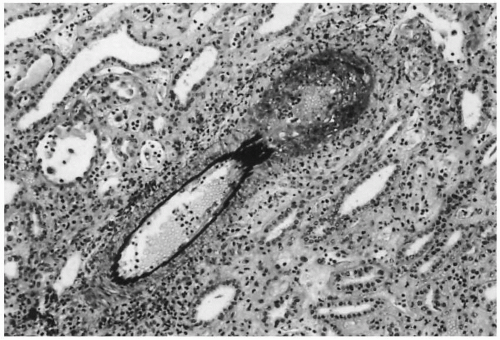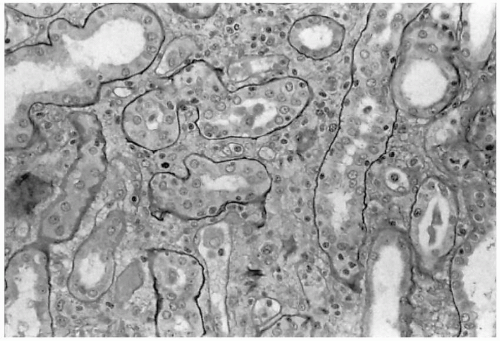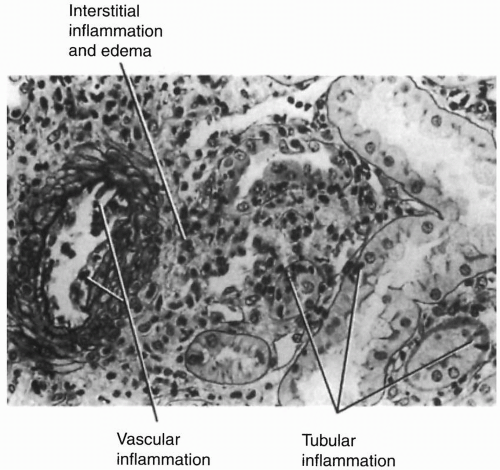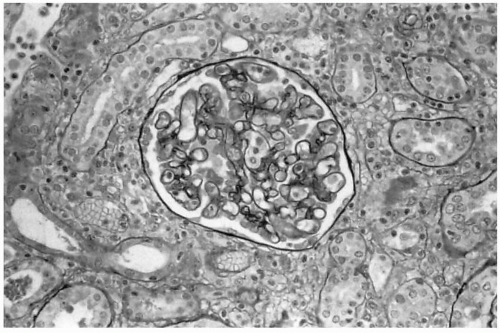Indications and Technique
Kidney transplant biopsies are most frequently performed at times of graft dysfunction when the etiology cannot be accurately elucidated by clinical or noninvasive means. Protocol biopsies are performed at predetermined intervals after transplantation at some centers in an attempt to recognize so-called subclinical rejection (see
Chapter 9); they also may be required as part of clinical trials for the evaluation of new immunosuppressive drugs (see
Chapter 5). More precise clinical indications for biopsy are reviewed in
Chapters 9 and
10. Transplantation programs vary in their reliance on biopsies and the clinical setting in which biopsies are performed.
Preparations for transplant biopsy are similar to those for biopsy of the native kidney. Informed consent is required from patients, who should be specifically warned of the risk for bleeding and occasional damage to the graft (see “Complications,” later). Before biopsy, coagulation studies are usually performed, although in the absence of liver disease, use of anticoagulants, thrombocytopenia, or a clinical history of bleeding, these may not be necessary. The blood pressure should be controlled at a level of less than 160/100 mm Hg.
The locations of the graft and biopsy site can be determined by palpation or by ultrasound guidance. A small pillow or towel rolled in the small of the patient’s back may facilitate palpation. Ultrasound offers the advantage of more precise localization of the graft and its depth and may reduce the frequency of inadequate specimens. Ultrasound may detect perinephric fluid collections or hydronephrosis. It is unwise to perform biopsy through a fluid collection because of the inability to tamponade the biopsy site adequately. Significant hydronephrosis should be relieved before the biopsy is performed because it may be the cause of the graft dysfunction; a small blood clot after the biopsy may exaggerate the degree of obstruction. Generally, the upper or lower pole of the transplant is sought, depending on which is more easily palpated or is nearer the surface. If the location of the biopsy site is difficult to ascertain or if the kidney is deep, it is wise to use real-time ultrasound with visual guidance or a fixed biopsy guide device (see
Chapter 13).
Disposable automatic spring-loaded needles (18-gauge needles are usually adequate) have largely replaced the traditional modified 14-gauge Vim-Silverman needle and may be less traumatic to the kidney. The site chosen for the biopsy is locally anesthetized with 1% lidocaine, and a small stab wound in the skin is made to facilitate the passage of the needle. Precise instructions for use of the newer needles are provided in the package inserts. The needles are advanced up to the depth determined by ultrasound or until an increase in resistance is felt as the needle makes contact with the kidney. When the automatic needles are used, it may be advisable to withdraw the needle slightly before taking the sample to avoid excessive depth and ensure a cortical sample.
Two biopsy cores should be adequate. It is advisable to inspect the specimen immediately with a stereomicroscope to ensure adequacy. As soon as the needle is withdrawn, hemostasis should be augmented by manual compression or with a sandbag. Postbiopsy orders should include observation of the patient’s vital signs every 15 minutes for at least 2 hours and then hourly for several hours. Patients initially should be immobile; in the absence of macroscopic hematuria, ambulation can begin after 6 to 8 hours. Many transplantation centers permit outpatients to go home the same day the biopsy is performed.
Complications
Core needle biopsy is an invasive technique and is not risk free; these risks must be weighed against the benefit gained from the information obtained from the procedure. Careful assessment of potential risks and benefits must precede every decision to subject a patient to a biopsy.
All major complications after needle biopsy manifest as perinephric or urinary bleeding. Transient macroscopic hematuria is common and is of little clinical significance. Macroscopic hematuria follows about 3% of biopsies and may prolong hospitalization or lead to blood transfusion or placement of a bladder catheter for clot drainage. Ureteral obstruction occasionally occurs, requiring placement of a percutaneous nephrostomy; massive hemorrhage necessitating surgical exploration, graft nephrectomy, or angiographic embolization is rare. Postbiopsy arteriovenous fistulas sometimes may be detected by Doppler ultrasound and usually can be treated expectantly. Angiographic embolization may occasionally be required, and graft loss has been reported.
Specimen Handling
Detailed methods for handling tissue specimens are beyond the scope of this chapter. For all specimens, portions are obtained for each of the three traditional methods of evaluating renal parenchyma: light microscopy, immunofluorescence, and electron microscopy. For the initial biopsy, all methods should be used; for subsequent biopsies, electron microscopy is performed only if indicated. This approach allows the pathologist to obtain maximal diagnostic and prognostic information. In selected instances, rapid processing or frozen sections can be performed on the tissue placed in fixative for light microscopy when an immediate assessment of the changes in the graft is necessary for initiating or modifying therapy.











